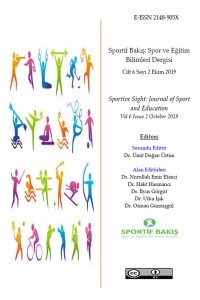Abstract
Konut proje alanları kentsel yaşam kalitesini arttıran en önemli unsurlardan olmalarının yanı sıra hızlı kentleşme etkisi ile günden güne önem kazanan ve birçok açıdan işlevsel bölgelerdir. Bu çalışma ile konut projelerinde bireylere sunulan spor ve rekreasyon alanlarının belirlenmesi amaçlanmıştır. Çalışmada nitel araştırma teknikleri boyutunda yazılı veri kaynaklarının analizini kapsayan doküman incelemesi yöntemi kullanılmıştır (Büyüköztürk ve ark., 2012). Doküman incelemesi Kocaeli İli sınırlarında faaliyet gösteren 24 inşaat/konut firmasının 29 adet konut projesini kapsamaktadır. Doküman incelemesi süreci aşamalarına göre dokümana ulaşma, dokümanların orijinalliğinin kontrol edilmesi, kullanım izni, dokümanların anlaşılması ve analiz edilmesi, son aşama olarak verilerin kullanılması yolu izlenmiştir (Yıldırım ve Şimşek, 2004). Araştırma verileri konut projelerinin tanıtımına yönelik inşaat/konut firmalarının hazırladıkları katalog, kitapçık ve broşürlerden elde edilmiştir. Elde edilen verilere göre konut projeleri içerisinde yaklaşık olarak 3188 konutun yer aldığı belirlenmiştir. Ayrıca projeler içerisinde 21 farklı başlıkta konut projelerinde 22 yüzme havuzu, 22 çocuk oyun alanı, 17 fitness, 15 basketbol sahası, 8 sosyal donatı ve 8 sauna olmak üzere 92 adet sportif ve rekreasyon alanları yer almaktadır. Bunların yanında konut projelerinde çevrede yer alan spor tesisleri, sosyal yaşam alanları, rekreasyon alanları ve diğer cazip yerler belirtilmiştir. Sonuç olarak incelenen konut projelerinin bir çoğunda spor ve rekreasyon alanları konutta yaşayanlara sunulmak üzere belirtilmiştir. Yaşam alanın içerisinde yer alacak bu tür projelere yönelik yer seçimi ve alanların inşası sonrası hizmete sunulması süreçleri önem arz etmektedir. Konut projelerinde yer alacak spor ve rekreasyon alanlarının planlama ve hizmet vermesi boyutunda akademik çalışmaların yapılması araştırmacılar tarafından önerilmektedir.
Keywords
References
- a
Abstract
The residential project areas are not only the most important elements that increase the quality of urban life but they are also functional areas that gain importance from day to day with the effect of rapid urbanization. With this study, it was aimed to determine the sports and recreation areas presented to the residents in residential projects. In the present study, the document review method which includes the analysis of the written data sources in the dimension of qualitative research techniques was used. The document review covers 29 residential projects of 24 construction / housing companies operating in the Kocaeli Province. At the stages of document review process, accessing the document, controlling the authenticity of the documents, permission to use, understanding and analyzing the documents, and using the data as the last stage have been followed (Yıldırım and Şimşek, 2004). The research data was obtained from catalogs, brochures and brochures prepared by construction / housing companies for the promotion of housing projects. According to the obtained data, it was determined that approximately 3188 dwellings were included in housing projects. In addition, there are 22 swimming pools, 22 children's playgrounds, 17 fitness, 15 basketball courts, 8 social facilities and 8 saunas, sports and recreation areas in 21 different projects in the housing projects. In addition to these, housing projects include sports facilities, social habitats, recreational areas and other attractive places in the surrounding area. As a result, sports and recreation areas in residential projects have been stated to be presented to residents in many projects. It is important to select the places for these areas to be included in the living area and to submit the areas to the postconstruction service. Researchers are advised to conduct academic studies on the planning and service aspects of sports and recreation areas in housing projects.
Keywords
References
- a
Details
| Primary Language | Turkish |
|---|---|
| Subjects | Sports Medicine |
| Journal Section | Leisure and Recreation Studies |
| Authors | |
| Publication Date | October 10, 2019 |
| Published in Issue | Year 2019 Volume: 6 Issue: 2 |


